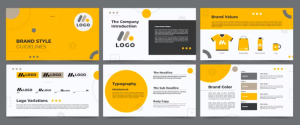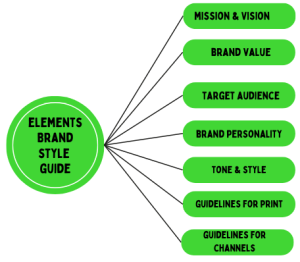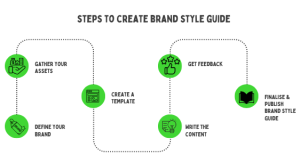What is a Brand Style Guide? How to Create it for Your Business?
Let’s first explore FabIndia’s style guide and try to understand what brand style means.
FabIndia’s brand style embodies traditional elegance, celebrating India’s rich heritage through handcrafted textiles and artisanal designs. It blends authenticity with modernity, offering a touch of India’s diverse cultural value in every piece.
This is the brand style of FabIndia.

A brand style guide ensures consistent visual and messaging elements, fostering brand recognition and a cohesive identity across all communication channels. If you are looking for a perfect brand style for your business, it is best you read the guide first.
What Is A Brand Style Guide?
It is a comprehensive document that outlines the consistent visual, design, and messaging elements that define a brand’s identity. It is a reference tool to ensure uniformity across all communications, enhancing brand recognition and maintaining a cohesive and impactful brand image.

Brand Guidelines Tips
Here are some tips for creating a perfect guide:

-
- Start with your brand identity.
When you are starting with creating a brand identity, think of the brand’s core values and what exactly you want your brand to represent. Once you clearly understand your brand identity, you can start developing your brand guide.
- Be specific.
For a brand guidelines tips, you can specify the exact shade colours you will use with your brands. Specify the exact shades and how they should be used together. The same rule goes for your typography, imagery, and other brand elements.
- Be consistent.
You can’t be golden one day and white the other day because for a brand consistency is the major aspect. And keep it consistent across all the channels.
- Make it easy to use.
Keep the brand guide easy to understand and use. You may also include examples of how your brand should be used in different situations.
- Get feedback.
Once you have a draft of your brand’s guide, get input from others, such as your team members, customers, and partners. This will help ensure your brand’s guide is clear, concise, and practical.
The elements of Brand Style Guide
Here are some of the elements of a guide in more detail:
- Brand identity: This is the foundation of your brand style guide. It includes your brand’s name, logo, tagline, colours, typography, and imagery. These elements should be used consistently across your marketing materials and communications.
- Brand voice: This is your brand’s tone and style of communication. It should be consistent with your brand identity and should be used to create a unique and memorable impression on your audience.
- Brand usage: This specifies how your brand should apply in different contexts, such as on your website, marketing materials, and social media. It should guide on everything like from the size and placement of your logo to the use of your colours and typography.
- Brand assets: These are the visual assets you use to represent your brand, such as your logo, fonts, and colours. These assets should be high-quality and used consistently across your marketing materials.
- Brand examples: Set some examples of how your brand guidelines should fall in place. It will help you keep your brand distinct and unique always. And it can be helpful for people who are new to using your brand or need help applying the brand guidelines.
Here are some other elements that may be included in a guide:

-
- Brand mission and vision: This defines the brand’s purpose and goals.
- Brand values: These are the beliefs and principles that the brand stands for.
- Target audience: This defines the people the brand is trying to reach.
- Brand personality: This describes the brand’s unique character and attributes.
- Brand guidelines for digital and print: Include the guidelines for how the brand should be used in different media, such as websites, social media, and print materials.
The elements included will vary depending on the brand’s needs and goals. However, the above mentioned elements are some of the most common and essential.
A well-written guide can help ensure the brand is communicated consistently and effectively across all channels. It can also help to protect the brand’s intellectual property and prevent misuse.
If you are creating a guide, involving all stakeholders in the process is important. They can better suggest for the brand’s management, marketing, creative, and legal teams.
How To Create A Brand Style Guide For Your Business?
This is how you can create brand style guide for your business:

- Define your brand: Identify the brand’s mission, vision, and values. You must specify what makes your brand unique. Give clear instructions on how and what do you want your brand to represent. Once your are clear with this, start designing the brand style guide.
- Gather your assets: This includes your brand’s logo, fonts, colours, imagery, and tagline. You may also want your brand’s mission, vision, and values.
- Create a template: This will help you organise your brand style guide and make finding the information you need easy. The template should include the following sections:
- Brand identity: This section should include your brand’s name, logo, tagline, colours, typography, and imagery.
- Brand voice: This section should define your brand’s tone and style of communication.
- Brand usage guidelines: This section should specify how your brand should be used in different contexts, such as on your website, in marketing materials, and on social media.
- Brand assets: This section should include high-quality versions of your logo, fonts, colours, and imagery.
- Brand examples: This section should include how your brand should be used differently.
- Write the content: This is where you will flesh out each section of your brand style guide. Be sure to be clear, concise, and easy to understand.
- Get feedback: Before finalising your brand style guide, get input from others, such as your team members, customers, and partners. This will help ensure your brand style guide is clear, concise, and practical.
- Finalise and publish your brand style guide: After you have finalised your brand style guide, ensure it is accessible to everyone who needs it. You can make it available online or in a physical binder.
Style Guide Examples
The Netflix brand style guide embodies simplicity and vibrancy. The iconic red “N” logo takes centre stage, surrounded by ample clear space.

The colour palette revolves around Netflix Red, balanced by neutral black, white, and grey tones. Typography leans on Gotham for a classic touch, while Netflix Sans offers a modern digital presence.
The imagery features high-quality visuals that resonate emotionally, focusing on beloved characters and captivating stories from shows and movies. Messaging maintains an approachable and relatable tone, fostering a connection with a diverse audience. This style guide ensures a consistent and recognizable brand identity across all platforms.
In another example, you can read about the brand style guide of Starbucks.
The Starbucks brand style guide exudes warmth and authenticity. The iconic Siren logo is the cornerstone, with a balanced mix of green and white. The colour palette extends to earthy tones, reflecting the brand’s connection to nature.

Typography embraces a unique blend of handcrafted and modern fonts, capturing Starbucks’ artisanal ethos. Imagery showcases genuine moments and community engagement, mirroring the brand’s commitment to inclusivity. This style guide ensures a consistent and inviting brand presence that resonates with coffee lovers worldwide.
Also Read : How Much Does a Logo Design Cost in India
Conclusion
A well-crafted brand style guide is a compass, steering your identity towards consistency and recognition. You create a lasting impression that resonates across every touchpoint by harmonising visual elements, typography, colours, and messaging.
Remember, a thoughtfully designed style guide reinforces your brand’s personality and amplifies its impact. For expert guidance in shaping your brand’s identity, contact us at hello[at]noboruworld.com.
FAQ
What is a brand style guide?
A brand style guide is a comprehensive document that outlines the visual, design, and messaging elements that define a brand’s identity. It serves as a reference tool to ensure consistency across all communications.
Why do I need a brand style guide?
A brand style guide ensures uniformity and coherence in your brand’s presentation, enhancing recognition and creating a cohesive brand image. It helps maintain design, messaging, and tone consistency across various platforms.
What elements does a brand style guide cover?
A brand style guide typically covers logo usage, colour palette, typography, imagery guidelines, messaging tone, and sometimes specific design applications for various materials.
How does a brand style guide benefit my business?
It ensures that your brand is presented consistently, regardless of who creates the content. This consistency builds trust, enhances brand recognition, and strengthens your brand identity.
Can a brand style guide be updated over time?
This can be updated to reflect changes in design trends, business strategies, or target audience preferences. It’s essential to periodically review and adjust the focus to keep it relevant and effective.
Also Read – THE BRANDING GUIDELINES ARCHIVE



